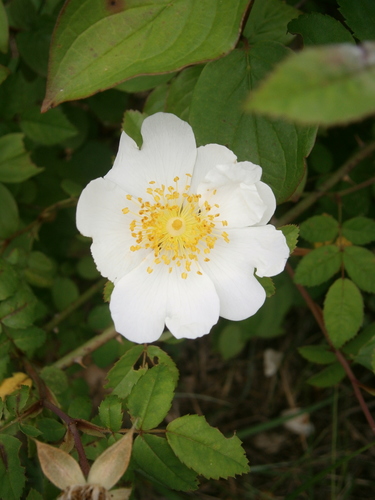Field Rose
Search
Wikipedia
| Rosa arvensis | |
|---|---|

| |
| Rosa arvensis in Lower Austria | |
|
Scientific classification | |
| Kingdom: | Plantae |
| Clade: | Tracheophytes |
| Clade: | Angiosperms |
| Clade: | Eudicots |
| Clade: | Rosids |
| Order: | Rosales |
| Family: | Rosaceae |
| Genus: | Rosa |
| Species: |
R. arvensis
|
| Binomial name | |
|
Rosa arvensis | |
Rosa arvensis, the field rose, is a species of wild rose native to Western, Central and Southern Europe.
Names
The plant is variously known as the Field Rose[2] and white-flowered trailing rose.[3] It may also be called Shakespeare’s musk.[4]
Classification
The following synonyms were recognised in October 2018:[5]
- Rosa pervirens (Rosa arvensis × sempervirens)
- Rosa polliniana (Rosa arvensis × gallica)
- Rosa repens
Rosa arvensis is closely related to Rosa sempervirens L. and Rosa phoenicia Boiss.[6]
Description
The plant can grow to be between 3 and 3.7 metres (9.8 and 12.1 ft) tall. Its flowers are white, 4 to 5 centimetres (1.6 to 2.0 in) across, and its fruits ('hips') are red. It blooms in the summer (July in England,[2] May–June in Bulgaria).[7]
Distribution
Rosa arvensis was first identified in England and has been subsequently observed elsewhere in Europe.[4][8] In England, it can be seen principally in hedges and thickets,[3] while in Bulgaria, it also forms part of the understory of deciduous forests.[7]
It is found in most of the British Isles (except Scotland), France and Belgium, the Pyrenees (at altitudes up to 1000 m) and in more scattered localities elsewhere in Spain, in the west and south of Germany, the foothills of the Alps (up to 1330 m in the Central and Eastern Alps, up to 1400 m in the Maritime Alps), in Italy, Western Hungary, in the Little Carpathians of Slovakia, the Carpathians of Romania, most of the Balkan Peninsula (in Bulgaria up to 1000 m).[9] It has been reported in isolated ccurrences in North-western Africa, southern Anatolia and the Levant, but it is likely these are instead instances of R. phoenicia. In Caucasia it is present only as a cultivated plant.[10]
References
Citations
- ^ Hudson 1762, p. 192.
- ^ a b Beales 1988, p. 208.
- ^ a b White 1912, p. 299.
- ^ a b Harkness 1978, p. 150.
- ^ "Flora Europea". Retrieved 4 October 2018.
- ^ MJW 1965, T535.
- ^ a b Dimitrov 1973, p. 122.
- ^ Kollár & Balkovic 2006, p. 61.
- ^ AFE 2004, p. 41; MJW 1965, T535, K224; Dimitrov 1973, p. 122
- ^ AFE 2004, p. 42.
Bibliography
- Beales, Peter (1988). Twentieth-century Roses: An Illustrated Encyclopaedia and Grower's Manual of Classic Roses from the Twentieth Century. New York: Harper & Row. ISBN 978-0-06016-052-4.
- Dimitrov, Stojan (1973). "Shipka – Rosa L.". In Vǎlev, Stoju; Asenov, Ivan (eds.). Flora na Narodna Republika Bǎlgarija (in Bulgarian). V. Sofia: Bulgarian Academy of Sciences.
- Harkness, Jack Leigh (1978). Roses. London: J.M. Dent. ISBN 978-0-46004-328-1.
- Hudson, William (1762). Flora anglica; exhibens plantas per regnum angliae sponte crescentes, distributas secundum systema sexuale: cum differentiis specierum, synonymis auctorum, nominibus incolarum, solo locorum, tempore florendi, ofììcinalibus pharmacopoeorum. London: J. Nourse.
- Kollár, Jozef; Balkovic, Juraj (2006). "Charakteristika lokality s vyskytom Rosa arvensis v Malych Karpatoch". Bulletin Slovenskej Botanickej Spoločnosti (in Slovak). 28: 61–65.
- Kurtto, Arto; Lampinen, Raino; Junikka, Leo (2004). Atlas florae Europaeae, distribution of vascular plants in Europe. 13: Rosaceae (Spiraea to Fragaria, excl. Rubus). Helsinki: Committee for mapping the flora of Europe and Societas Biologica Fennica. pp. 41–42. ISBN 978-951-9108-14-8.
- Meusel, Hermann; Jäger, E.; Weinert, E. (1965). Vergleichende Chorologie der zentraleuropäischen Flora. [Band I]. Jena: Fischer.
- White, James Walter (1912). The Flora of Bristol: Being an Account of All the Flowering Plants, Ferns, and Their Allies that Have at Any Time Been Found in the District of Bristol Coal-fields. Bristol: John White & Sons.

